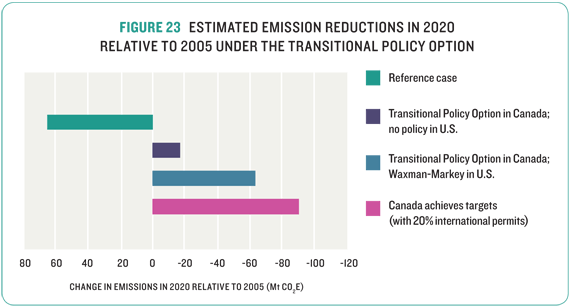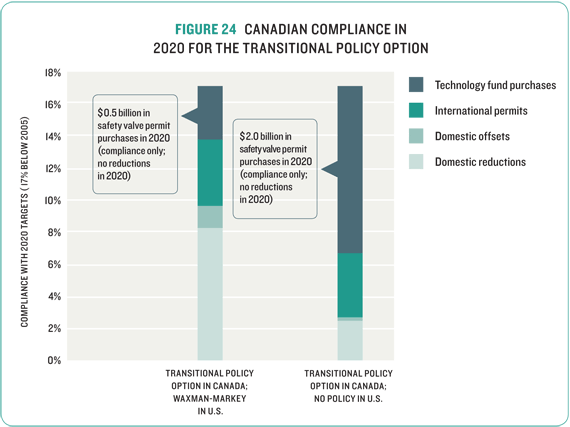Parallel Paths – 5.5 Environmental Outcomes of the Transitional Policy Option
What would be the environmental outcomes of this Transitional Policy Option?
We selected a $30 maximum differential as a balanced and responsible approach to achieving significant reductions but that also ensures manageable impacts. Figure 23 illustrates the environmental side of this trade-off. It shows the domestic Canadian emission reductions achieved under the policy proposal relative to 2005 levels and the reference case.
Under the Transitional Policy Option, Canada’s emissions in 2020 would be lower than 2005 levels whether the U.S. implements policy or not. But more importantly, the Transitional Policy Option would curtail the large emissions growth that would occur under the reference case, setting Canada on the path toward long-term emissions reductions.
Under the Transitional Policy Option, Canadian firms will achieve compliance with the policy in different ways, depending on whether or not the U.S. implements policy. Figure 24 shows the breakdown of emission reductions by method of compliance likely to be used for Canadian firms to comply with their share of a Canadian emissions cap. It illustrates that if the U.S. did not implement policy and the carbon price was limited in Canada, the lower Canadian carbon price would result in less domestic action, both in terms of emission reductions and domestic offsets. The compliance gap to the overall cap would need to be made up through additional investments in the technology fund. Note that if low-cost international reductions from developing countries were not available, the carbon price under the Transitional Policy Option would still not be affected. However, it would result in less compliance achieved through international permits and more compliance achieved through the technology fund.
The Transitional Policy Option brings about real carbon abatement and emission reductions in Canada whether the U.S. implements equivalent policy or not. NRTEE modelling shows that Canada would achieve a 10 % reduction in domestic emissions relative to 2005 levels if the U.S. implemented policy, and a 3 % reduction if the U.S. continued to lag. This means Canadian emissions growth would be arrested and on a path to being reduced altogether. Since contingent policy is a transitional measure designed to move Canada forward on climate policy in the face of continued U.S. policy uncertainty, there is an initial emphasis on cost containment. This means that a significant amount of emission reductions would occur through compliance mechanisms such as the purchase of international permit purchases and / or the purchase of safety valve compliance permits through a technology fund. Both have implications for GHG emissions. Efforts would have to be made to ensure that international permits were real, credible, and verifiable, and not merely so-called hot-air permits that do not represent real reductions. Use of the safety valve would also reduce environmental effectiveness for 2020, but since revenues from the safety valve would be recycled to technology, it would provide financing for key technologies important for longterm reductions.
In the short term, the Transitional Policy Option would increase the development and implementation of low-carbon technologies because it provides a clear price signal to the economy, no matter what policy choices the U.S. makes. However, to address risks of competitiveness, the option limits, or caps, the Canadian carbon price and thus the incentives for more costly low-carbon technologies as well. Of particular risk for Canada is that the price is kept below thresholds at which CCS becomes economically viable. In the long term, CCS could be a critical technology for Canada’s oil and gas industries to remain competitive in a low-carbon global economy. The Transitional Policy Option by itself could limit expectations for high Canadian carbon prices over the medium term, and thus inhibit the development of CCS and other technologies.
To help address this issue, the Transitional Policy Option we put forward would devote revenue from the safety valve to a new Canadian low-carbon technology fund focused on research and development and on commercialization of low-carbon technologies, including CCS. The technology fund included here would generate a significant amount of revenue for low-carbon technologies that, invested and managed properly, could lead to ongoing emission reductions.


























